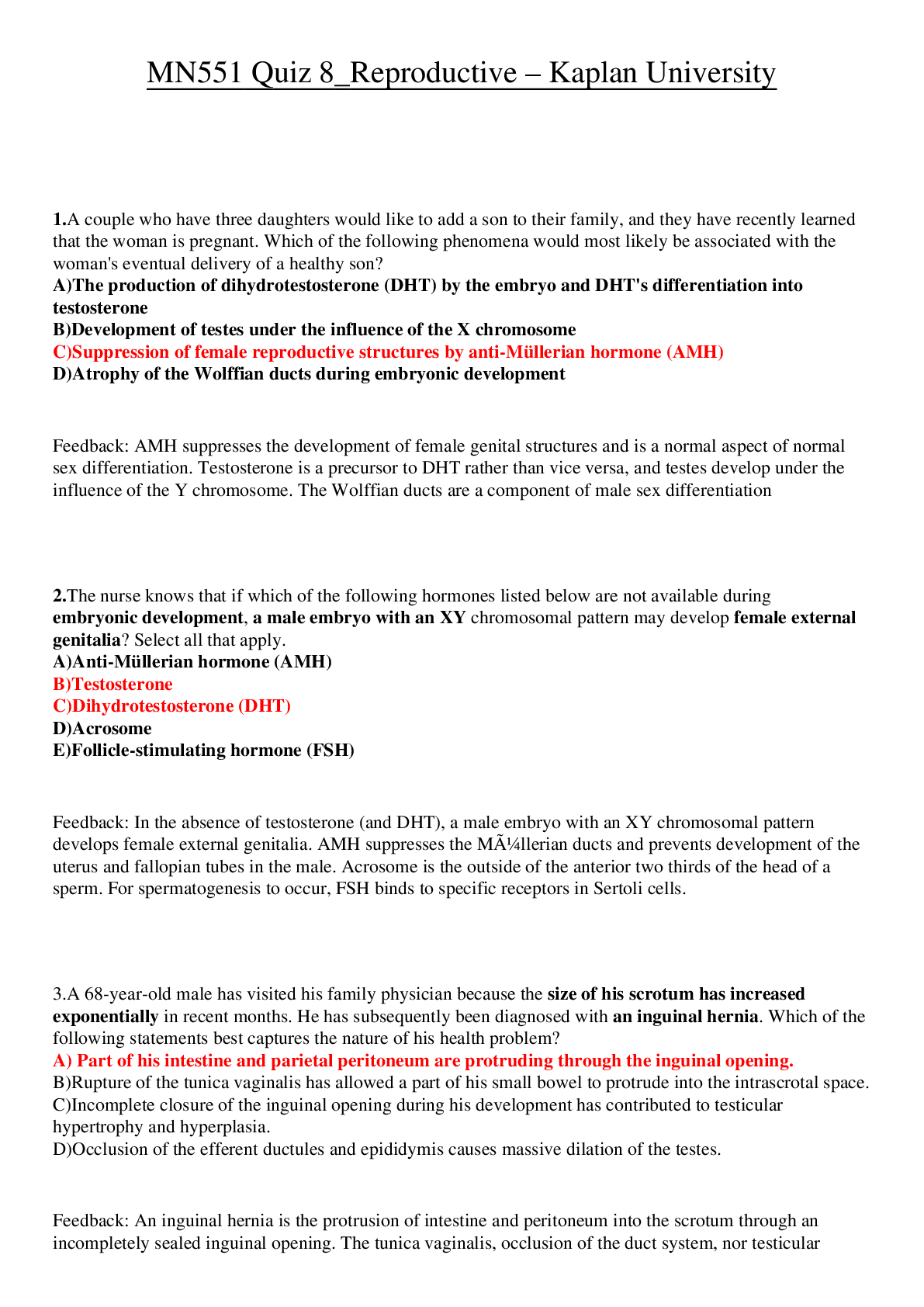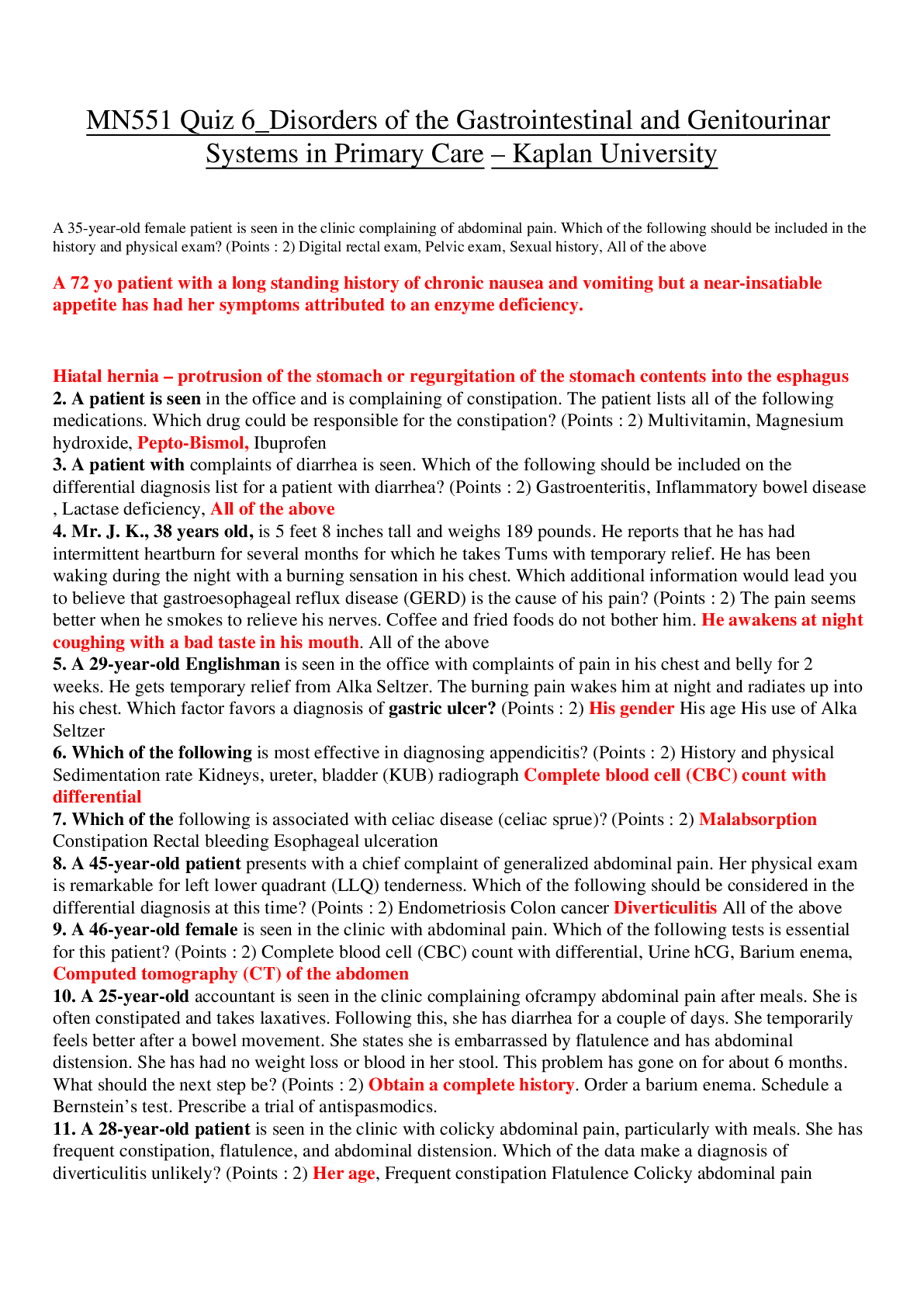*NURSING > EXAM > MN 551 Quiz 8_2020_Reproductive | MN551 Quiz 8_2020_Reproductive - Kaplan University (All)
MN 551 Quiz 8_2020_Reproductive | MN551 Quiz 8_2020_Reproductive - Kaplan University
Document Content and Description Below
MN551 Quiz 8_Reproductive – Kaplan University 1.A couple who have three daughters would like to add a son to their family, and they have recently learned that the woman is pregnant. Which of ... the following phenomena would most likely be associated with the woman's eventual delivery of a healthy son? A)The production of dihydrotestosterone (DHT) by the embryo and DHT's differentiation into testosterone B)Development of testes under the influence of the X chromosome C)Suppression of female reproductive structures by anti-Müllerian hormone (AMH) D)Atrophy of the Wolffian ducts during embryonic development Feedback: AMH suppresses the development of female genital structures and is a normal aspect of normal sex differentiation. Testosterone is a precursor to DHT rather than vice versa, and testes develop under the influence of the Y chromosome. The Wolffian ducts are a component of male sex differentiation 2.The nurse knows that if which of the following hormones listed below are not available during embryonic development, a male embryo with an XY chromosomal pattern may develop female external genitalia? Select all that apply. A)Anti-Müllerian hormone (AMH) B)Testosterone C)Dihydrotestosterone (DHT) D)Acrosome E)Follicle-stimulating hormone (FSH) Feedback: In the absence of testosterone (and DHT), a male embryo with an XY chromosomal pattern develops female external genitalia. AMH suppresses the Müllerian ducts and prevents development of the uterus and fallopian tubes in the male. Acrosome is the outside of the anterior two thirds of the head of a sperm. For spermatogenesis to occur, FSH binds to specific receptors in Sertoli cells. 3.A 68-year-old male has visited his family physician because the size of his scrotum has increased exponentially in recent months. He has subsequently been diagnosed with an inguinal hernia. Which of the following statements best captures the nature of his health problem? A) Part of his intestine and parietal peritoneum are protruding through the inguinal opening. B)Rupture of the tunica vaginalis has allowed a part of his small bowel to protrude into the intrascrotal space. C)Incomplete closure of the inguinal opening during his development has contributed to testicular hypertrophy and hyperplasia. D)Occlusion of the efferent ductules and epididymis causes massive dilation of the testes. Feedback: An inguinal hernia is the protrusion of intestine and peritoneum into the scrotum through an incompletely sealed inguinal opening. The tunica vaginalis, occlusion of the duct system, nor testicular hypertrophy and hyperplasia contribute to the etiology. 4.The cremaster muscles work in concert with the pampiniform plexus that surrounds the testicular artery to: A) move the testes into the scrotum. B) maintain testicular temperature. C)empty fluid from the seminal vesicles into the genital ducts. D)move sperm from the ampulla to the penis. Ans: B: Feedback: The location of the testes in the scrotum is important for sperm production, which is optimal at 2 °C to 3 °C below body temperature. Two systems maintain the temperature of the testes at a level consistent with sperm production. One is the pampiniform plexus of testicular veins that surround the testicular artery. This plexus absorbs heat from the arterial blood, cooling it as it enters the testes. The other is the cremaster muscles. These muscles respond to decreases in testicular temperature by moving the testes closer to the body. 5.A couple has been trying to get pregnant for over 2 years. After infertility testing, the physician has informed the male that he has a low sperm count. The nurse knows which of the following causes of low sperm count may lead to impaired spermatogenesis The nurse knows which of the following causes of low sperm count may lead to impaired spermatogenesis? Select all that apply. A)Prolonged fever B)Wearing tight briefs rather than boxers C)Undescended testes D)Swimming in cold-water lakes E)Vacationing in a tropical location Ans A,B,C – Feedback: Prolonged exposure to elevated temperatures, as a result of prolonged fever, tight undergarments, and failure of the testes to descend into the scrotum can result in decreased sperm counts. 6.A client comes to the college campus nurse complaining of unilateral pain, swelling, and redness on his scrotal area. The nurse knows these clinical manifestations are likely caused by: A) Syphilis B) Testicular torsion C) Epididymitis D) Ticks bites Ans: C Feedback:Epididymitis is characterized by unilateral pain and swelling, accompanied by erythema and edema of the overlying scrotal skin that develops over a period of 24 to 48 hours. Initially, the swelling and induration are limited to the epididymis. Syphilis is a sexually transmitted disease that is contagious and caused by a spirochete (Treponema pallidum). If left untreated it can produce chancres, rashes, and systemic lesions in a clinical course with three stages continued over many years. Twisting of the spermatic cord (which is very painful) with a resulting compromise of the blood supply to the testis is known as testicular torsion. There is no indication that the client has experienced a tick bite. **If left untreated it can produce chancres, rashes, and systemic lesions in a clinical course with three stages continued over many years. Twisting of the spermatic cord (which is very painful) with a resulting compromise of the blood supply to the testis is known as testicular torsion. There is no indication that the client has experienced a tick bite 7. A 30-year-old man has been diagnosed with mumps orchitis. The nurse should educate the client that which of the following complications may occur? A)Erectile dysfunction B)Hematocele formation C)Sterility D)Penile atrophy Ans:C Feedback:The residual effects seen after the acute phase of mumps orchitis include hyalinization of the seminiferous tubules and atrophy of the testes, along with impaired spermatogenesis that has the potential to result in sterility. Spermatogenesis is irreversibly impaired in approximately 30% of testes damaged by mumps orchitis. Penile atrophy, hematuria, and hematocele are not among the signs, symptoms, and sequelae of mumps orchitis. 8. After seeking care due to recent history of testicular enlargement and scrotal pain, a 22-year-old college student has been diagnosed with testicular cancer. Which of the client's following statements indicates the need for further teaching? A)“I can't shake this feeling like I've received a death sentence.” B)“I have to admit that the prospect of losing a testicle is a bit overwhelming.” C)“I really hope the cancer hasn't spread anywhere, because I've read that it's a possibility.” D)“I guess there's some solace in the fact that this cancer wasn't a result of an unhealthy lifestyle.” Ans:A Feedback:Testicular cancer has the potential for metastasis, but outcomes are positive for most clients and survival rates are high. With appropriate treatment, the prognosis for men withtesticular cancer is excellent. Orchiectomy remains the standard treatment, and the pathogenesis of testicular cancer is not thought to be related to lifestyle factors 9. Which of the following clients is at high risk for developing acute bacterial prostatitis? A)A middle-aged male with prostate hyperplasia B)A fifth grade male diagnosed with acute pyelonephritis C)An elderly male diagnosed with frequent UTIs testing positive for gram-negative rods D) A sickle cell anemia client complaining of prolonged erection lasting less than 4 hours Ans: C Feedback:The most likely etiology of acute bacterial prostatitis is an ascending urethral infection or reflux of infected urine into the prostatic ducts. E. coli, other gram-negative rods, and enterococci, organisms known to cause urethritis are the most common infectious agents, rather than a descending bacterial infection from the kidneys (as in pyelonephritis). ******** A) The presence of relative or absolute hypogonadism B) A decrease in the size and firmness of the patient's testes C) Cessation of FSH production D) A decrease in the force of the man's ejaculation ************ 10. Which of the following statements best captures an aspect of the neural control of sexual function? A) The sensory system contained in the testes communicates with the spinal cord by way of afferent pathways. B) Perineal stimulation transmits signals to the thalamus and hypothalamus. C) The spinal cord plays a central role, with the limbic system and cerebral cortex also contributing. D) Sympathetic stimulation causes the shunting of blood that results in erection, while parasympathetic stimulation results in detumescence. Feedback: Afferent impulses from sensory receptors in the glans penis pass through the pudendal nerve to ascending fibers in the spinal cord by way of the sacral plexus, while stimulation of other perineal areas can transmit signals to higher brain centers, such as the limbic system and cerebral cortex. The thalamus and hypothalamus do not play a central role in the neural control of male sexual function, and arousal can result from parasympathetic stimulation. 11. A 68-year-old man has revealed to his care provider that he is distraught over his increasingly frequent inability to maintain an erection. Which of the following teaching points is most warranted? A) “After the age of 65, erectile dysfunction is largely inevitable and untreatable.” B) “With lifestyle modifications like exercise, weight loss, and quitting smoking, you can most likely correct this and prevent it in the future.” C) “While this problem is often a part of the aging process, it might be a result of some of the medications that you take.” D) “Most often this problem is transient and will resolve with time.” 12. During unprotected sex, a 17-year-old female high school senior has been exposed to the human papillomavirus (HPV). The school nurse would recognize that the student is at a considerable risk for developing which of the following diagnoses? A) Genital herpes B) Gonorrhea C) Condylomata acuminata D) Candidiasis Feedback: HPV is an identified precursor to condylomata acuminata, or genital warts. Herpes, gonorrhea, and candidiasis are not likely to result directly from HPV. 2. A campus-based peer counseling group is conducting an information blitz on sexually transmitted infections. Which of the following statements about genital warts requires correction? A) “Genital warts can take up to a month after exposure to first become visible.” B) “There is no existing treatment that can eradicate the virus once it's contracted.” C) “Condoms do not necessarily prevent the transmission of the virus that causes genital warts.” D) “There are a number of subtypes of the virus that causes genital warts, but current vaccines protect against most of them.” Feedback: Genital warts can take between 6 weeks to 8 months to incubate after exposure. The virus cannot be eliminated, and condoms do not provide proven protection. Vaccine protects against 4 HPV type 3. A 31-year-old male was diagnosed with genital herpes of the HSV-2 type 5 years ago. He is now broaching the subject with a woman he has recently formed a relationship with. Which of his statements is most accurate? A) “If you've been exposed to the herpes virus in the past, then there's no significant risk of reinfection.” B) “The worst-case scenario is that you'll develop cold sores, since this is the type of herpes virus that I've got.” C) “If you've had cold sores when you were younger, it means that you've got antibodies against this type of herpes virus.” D) “Even when I'm not having a recurrence, I could still pass the virus on to you.” Feedback: HSV transmission can occur both during and between recurrences. HSV-2 is associated more with genital herpes than cold sores, and cold sores do not provide antibody protection. Prior contact with the virus does not confer immunity. 4. A pregnant 23-year-old with a diagnosis of herpes simplex virus (HSV) is receiving prenatal care from her family physician. What is the physician most likely to tell the patient about the precautions that will be taken to prevent transmission of the virus to her baby? During a health history, a 22-year old woman asks, "Can I get that vaccine for HPV? I have genital warts and I'd like them to go away!" What is the nurse's best response? A) "The HPV vaccine is for girls and women ages 9 to 26, so we can start that today." B) "This vaccine is only for girls who have not started to have intercourse yet." C) "Let's check with the physician to see if you are a candidate for this vaccine." D) "The vaccine cannot protect you if you already have an HPV infection." Feedback: The HPV (human papillomavirus) vaccine is appropriate for girls and women age 9 to 26 and is given to prevent cervical cancer by preventing HPV infections before girls become sexually active. However, it cannot protect the woman if an HPV infection is already present. A 71-year-old man has visited his family physician for a checkup, during which the physician has initiated a discussion about the client's sexual function. Which of the following phenomena would the physician most likely consider pathological rather than age-related changes? A) The presence of an enlarging prostate gland B) A decrease in the size and firmness of the client's testes C) Cessation of androgen production D) A decrease in the force of the man's ejaculation If a male has a history of impaired blood flow in his vascular system, he may be prone to develop A) premature ejaculation. B) erectile dysfunction. C) penile engorgement. D) vascular clots in pudendal arteries 19. A 68-year-old man has revealed to his care provider that he is distraught over his increasingly frequent inability to maintain an erection. Which of the following teaching points is most warranted? A) “Above the age of 65, erectile dysfunction is largely inevitable and untreatable.” B) “With lifestyle modifications like exercise, weight loss, and quitting smoking, you can most likely correct this and prevent it in the future.” C) “While this problem is often a part of the aging process, it might be a result of some of the medications that you take.” D) “Most often this problem is transient and will resolve with time 20. A 21-year-old college football player has acknowledged to a nurse at a campus clinic that he has been injecting androgens in an effort to increase the size of his musculature and enhance his on-field performance. Which of the following teaching points should the nurse include in a conversation with the player? A) “You run a real risk of developing acne and developing breasts by doing this.” B) “You will indeed be able to increase your muscles, but they will rebound by shrinking smaller than they ever were within a few months.” C) “Most of the people who do this cause themselves to be permanently sterile.” D) “A reduction in the size of your penis and the production of mutated sperm can be an effect of steroid use. 7.A nursing student studying obstetrics asks the faculty, “How does the sperm get so much energy to swim up the fallopian tubes?” The instructor responds based on which pathophysiological principle? A)Usually the ejaculation is so powerful that it propels the sperm far up into the fallopian tubes. B)Fructose is secreted by the seminal vesicles and provides energy for motility of the sperm. C)The seminal vesicles secrete fluid for the semen, and they can secrete catecholamines that energize the sperm. D)Estrogen, which is being secreted when the ova are ripe and ready for penetration, assists by attracting the sperm in the right direction Following ejaculation in a healthy adult, approximately 300 million sperm is present. Which percent of these sperm would be considered normal (mobile and morphologically healthy) and able to fertilize an egg? A)95% B)75% C)55% D)45% Feedback : Approximately 3 mL of semen is expressed with each ejaculate, and each milliliter is made up of about 100 million sperm. However, approximately 20% of the sperm in any ejaculate are not morphologically normal and about 25% are immobile A couple has been trying to get pregnant for over 2 years. After infertility testing, the physician has informed the male that he has a low sperm count. The nurse knows which of the following causes of low sperm count may lead to impaired spermatogenesis? Select all that apply. A) Prolonged fever B) Wearing tight briefs rather than boxers C)Undescended testes D)Swimming in cold-water lakes E) Vacationing in a tropical location [Show More]
Last updated: 2 years ago
Preview 1 out of 11 pages

Buy this document to get the full access instantly
Instant Download Access after purchase
Buy NowInstant download
We Accept:

Reviews( 0 )
$12.50
Can't find what you want? Try our AI powered Search
Document information
Connected school, study & course
About the document
Uploaded On
Jun 13, 2020
Number of pages
11
Written in
Additional information
This document has been written for:
Uploaded
Jun 13, 2020
Downloads
0
Views
77








 – University of the People.png)

















